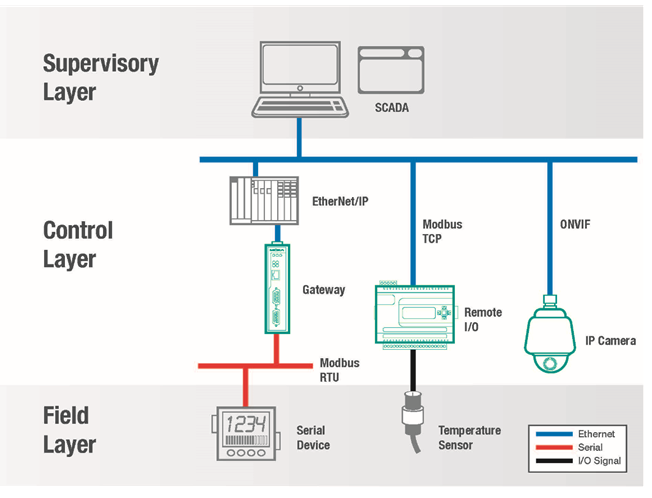The Industrial Internet of Things (IIoT) is fast becoming the cornerstone of automation. Although the IIoT’s inroads into a large number of industries is at full throttle—driving new capabilities for gathering information and changing the way we interact with machines and services— it is not always a smooth ride in IIoT-land. There are bumps in the road ahead for the implementation of the IIoT.
Heterogeneous networks, different protocols, and multiple devices make the IIoT complex and fragmented. Often, managing heterogeneous networks at field sites sends system operators into a frenzy of frustration and agony as getting the "Things" connected to the Internet is easier said than done. The trick is to bring all these different pieces together so that your IIoT strategy can shift your operations into top gear.
For the purpose of this article, our goal is to give you hands-on advice to easily navigate your first step towards Industrial IoT field connectivity. Therefore, we have put ourselves in your shoes so that we can point out the key factors you need to look out for when you take your first step into the Industrial IoT.
Managing Heterogeneous Networks at Field Sites
Collecting data from field devices in industrial automation applications has always been important. Now, getting that data on a network, although a big challenge, holds great potential for data analysis purposes. Temperature, motor speed, start/stop status, and video footage, can be used to gain new insights to tweak and streamline operations—ultimately, increasing competitiveness. For example, you can determine how to optimize your energy usage, production line performance, and even when to do preventive maintenance to reduce the amount of downtime. However, these devices often speak different languages: some use proprietary protocols, whereas others use open standard protocols. Whatever the case may be, you will need to find an efficient way to convert back and forth between one or more protocols.
Of course, saving money and time is always an issue. So, it is best to go about the issue of interoperability in one of the following three ways. Your requirements should determine the solution best suited for your operation.
Selecting Suitable Protocols
Many different protocols are used in various field devices. For example, Modbus RTU/ASCI is simple, easy to use, and cost-effective. If you just need to collect data every few seconds or more, then Modbus will be more than sufficient to do the job. But if you want to exchange data every 10 milliseconds, then PROFIBUS is a better solution. It’s more expensive to implement, but it’s extremely reliable in time-control applications. Because Ethernet is now well established in automation applications, Ethernet-based protocols are being used more frequently at field sites. Most Ethernet-based protocols are open standard protocols, such as Modbus/TCP, Profinet, OPC UA in automation, or ONVIF in video. When you design a new system, or upgrade an existing one, make sure your field devices support open standard protocols so that they are interoperable with devices from other vendors.
Integrating Different Protocols and Media Effectively
In the field, the entire network is separated into a field layer, a control layer, and a supervisory layer. Each layer has a different response time and deals with its own set of environmental factors. Needless to say, you can expect to encounter a variety of protocols that meet the requirements of each of the three aforementioned layers. After choosing the right protocol, the next step is to collect the applicable information from these devices with different protocols. A protocol gateway is usually the best solution for this type of integration. For example, it can convert a field layer protocol (e.g., Modbus RTU master) to a control layer protocol (e.g., Ethernet/IP or PROFINET PLC in the control layer).
To meet industrial environment requirements, different transmission media can be used to build the most reliable communications systems. For example, a fiber-optic cable is used for Modbus RTU communications because it can extend over a long distance. In cases of excessive electronic noise, a fiber-optic cable is also the best choice. So, when you plan your system, it is important to make sure vendors can provide a foolproof solution with regards to any communications issue. This includes different device interfaces (e.g., RS-232/R-485, remote IO), different network interfaces (e.g., optical fiber, Ethernet, wireless), and support for different protocols (e.g., fieldbus, DPC UA, ONVIF). Remember, a complete solution can save lots of valuable time during the system integration phase.

Handling Proprietary Protocols
We have already discussed standard protocols considerably. However, a large number of existing devices, ranging from power meters to barcode readers, use proprietary protocols. that operate through a serial interface . For some reason, however, Modbus RTU or DF1, which are very popular in the serial market, are not used. To connect such devices to an Ethernet network, you can use a serial-to-Ethernet converter, referred to in the industry as a serial device server. Two interfaces are supported: a serial interface on one side, and an Ethernet interface on the other side. Serial device servers support virtual COM ports that work as legacy COM ports in your SCADA system, allowing you to use the existing SCADA system without any redevelopment required. Serial device servers also support the so-called raw socket mode, which converts serial data to TCP or UDP packets transparently. Most SCADA and OPC servers support special drivers or libraries to work with serial device servers to receive proprietary protocols. You still have to handle the protocol manually as before, but serial device servers can help you transmit the data to an Ethernet network.
In our white paper “Hands-on Advice for Your First Step towards IIoT Field Connectivity,” solutions are also presented for the following scenarios: Configuring, Deploying, and Troubleshooting, and Maintaining Devices on a Large Scale; and Devices Are Damaged by Extreme Temperatures and Other Environmental Interference. To find out more, download the white paper here.